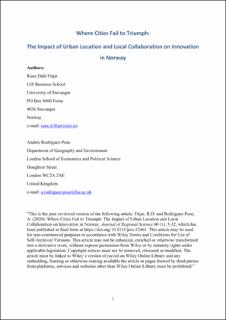| dc.contributor.author | Fitjar, Rune Dahl | |
| dc.contributor.author | Rodriguez-Pose, Andres | |
| dc.date.accessioned | 2022-01-14T12:25:54Z | |
| dc.date.available | 2022-01-14T12:25:54Z | |
| dc.date.created | 2019-09-05T08:35:15Z | |
| dc.date.issued | 2019-07 | |
| dc.identifier.citation | Fitjar, R.D., Rodriguez-Pose, A. (2019) Where cities fail to triumph: The impact of urban location and local collaboration on innovation in Norway. Journal of Regional Science, 60(1), 5-32 | en_US |
| dc.identifier.issn | 0022-4146 | |
| dc.identifier.uri | https://hdl.handle.net/11250/2837452 | |
| dc.description.abstract | The role of cities in fostering innovation has for long been taken for granted. Agglomeration and the knowledge spillovers generated in dense urban environments have been considered fundamental drivers of innovation. This view has, however, become challenged by research questioning the returns to physical agglomeration and local networking, placing instead more emphasis on the importance of interregional and international collaboration, and on innovation in peripheral regions. This paper delves into the debate on the role of cities for innovation by examining the interplay between urban location and local collaboration in Norway. It uses data from the Community Innovation Survey for 2006–2010 to map out the geographical dimension of R&D collaboration in Norwegian firms with a view to assessing whether different types of R&D collaboration in urban and rural locations affect firms’ propensity to innovate. The results show that local collaboration is associated with increased process and organisational innovation, while it does not produce higher levels of product or marketing innovation. Conversely, international collaboration is connected with higher probabilities of product, new-to-market and marketing innovations. Furthermore, location in urban or rural areas makes no difference for most innovation outcomes in Norway when other characteristics are controlled for. Location in cities also does not shape the returns to local R&D collaboration. Hence, the role of cities for innovation in Norway, whether in themselves or as sites for dense local interaction, is less relevant than the urban innovation literature would predict. | en_US |
| dc.language.iso | eng | en_US |
| dc.publisher | 2019 Wiley Periodicals, Inc. | en_US |
| dc.rights | Navngivelse-Ikkekommersiell 4.0 Internasjonal | * |
| dc.rights.uri | http://creativecommons.org/licenses/by-nc/4.0/deed.no | * |
| dc.subject | økonomi | en_US |
| dc.subject | regional utvikling | en_US |
| dc.subject | byer | en_US |
| dc.subject | innovasjon | en_US |
| dc.title | Where cities fail to triumph: The impact of urban location and local collaboration on innovation in Norway | en_US |
| dc.type | Peer reviewed | en_US |
| dc.type | Journal article | en_US |
| dc.description.version | acceptedVersion | en_US |
| dc.rights.holder | © 2019 Wiley Periodicals, Inc. | en_US |
| dc.subject.nsi | VDP::Samfunnsvitenskap: 200::Økonomi: 210::Bedriftsøkonomi: 213 | en_US |
| dc.source.pagenumber | 5-32 | en_US |
| dc.source.volume | 60 | en_US |
| dc.source.journal | Journal of Regional Science | en_US |
| dc.source.issue | 1 | en_US |
| dc.identifier.doi | 10.1111/jors.12461 | |
| dc.identifier.cristin | 1721726 | |
| cristin.ispublished | true | |
| cristin.fulltext | postprint | |
| cristin.qualitycode | 1 | |

